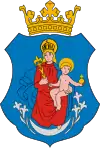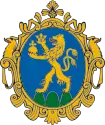Vác
Vác (Hungarian pronunciation: [ˈvaːt͡s]; German: Waitzen; Slovak: Vacov; Yiddish: ווייצען) is a town in Pest county in Hungary with approximately 35,000 inhabitants. The archaic spelling of the name is Vácz.
Vác | |
|---|---|
 .jpg.webp) .jpg.webp)  Vác Cathedral | |
 Flag  Coat of arms | |
 Vác Location of Vác  Vác Vác (Europe) | |
| Coordinates: 47.77518°N 19.13102°E | |
| Country | |
| County | Pest |
| District | Vác |
| Government | |
| • Mayor | Ilona Matkovich (Independent) |
| Area | |
| • Total | 61.60 km2 (23.78 sq mi) |
| Population (2013) | |
| • Total | 33,475 |
| • Density | 543/km2 (1,410/sq mi) |
| Time zone | UTC+1 (CET) |
| • Summer (DST) | UTC+2 (CEST) |
| Postal code | 2600 |
| Area code(s) | 27 |
Location
Vác is located 35 kilometres (22 miles) north of Budapest on the eastern bank of the Danube river, below the bend where the river changes course and flows south. The town is seated at the foot of the Naszály Mountain in the foothills of the Carpathians.[1]
Modern Vác
Vác is a commercial center as well as a popular summer resort for citizens of Budapest. The cathedral, built 1761–1777, was modelled after St. Peter's Basilica in Rome.[1] The episcopal palace houses a museum for Roman and medieval artifacts.[1] The city is also known for its 18th-century arch of triumph and for its beautiful baroque city center.
History
Settlement in Vác dating as far back as the Roman Empire has been found. The origin of its name is debated. One hypothesis says that the name comes from a Hungarian tribal name "Vath".[2] Another theory says the name comes from czecho-slovak personal name Vac (Vác), which is the diminutive form of Václav.[3]
It has been the seat of a Roman Catholic bishopric since the 11th century.[1] Bishops from the Roman Catholic Diocese of Vác were influential within the Kingdom of Hungary, with many serving as chancellors or later becoming archbishops.
On 17 March 1241, due to the attack of Mongols the population was slaughtered and Mongols set up camp there.[4][5][6] After the departure of the Mongols, Vác was rebuilt and German colonists were invited to the town.[2]
The town was conquered by the Ottoman Empire in 1541. During the Habsburg Monarchy's wars against the Ottomans, the Austrians won victories against the Turks at Vác in 1597 and in 1684.[1] After the Great Turkish War, Vác was rebuilt and repopulated. This re-population was both spontaneous and planned.[2] According to the Truce of Zsitvatörök, Habsburg control of the fortress at Vác (also known as Vacz) was maintained, and its repair was sanctioned.
During the Hungarian Revolution and War of Independence of 1848-49, the Honvédség routed the Austrian forces stationed in the city after a major battle (April 10, 1849); the Second Battle of Vác ended in Russian victory (July 17).
During World War II, Vác was captured on 8 December 1944 by Soviet troops of the 2nd Ukrainian Front in the course of the Budapest Offensive.
See also:
- Bishopric of Vác
Demographics
Ethnicity
- Hungarians : 94.9%
- Romani people : 1.3%
- Germans : 0.5%
- Romanians : 0.1%
- Slovaks : 0.5%
- Ukrainians : 0.1%
- Other/Undeclared: 4.5%
Religious denomination
- Roman Catholic: 59.4%
- Greek Catholic: 0.7%
- Calvinist: 9.3%
- Lutheran: 3.1%
- Other denomination: 1.4%
- Non-religious: 14.4%
- Undeclared: 11.5%
According to the 1910 census, the religious make-up of the town was the following:
Gallery
 The Sharpened Tower
The Sharpened Tower.jpg.webp) Vác - Cathedral
Vác - Cathedral The Arc of Triumph was built for Empress Maria Theresia's visit in 1764.
The Arc of Triumph was built for Empress Maria Theresia's visit in 1764.
International relations
Twin towns — Sister cities
|
References
- Chisholm, Hugh, ed. (1911). . Encyclopædia Britannica. 27 (11th ed.). Cambridge University Press. p. 837.
- "Vác - Várostörténet". www.vac.hu.
- STANISLAV, Ján. Slovenský juh v stredoveku II. 2. edition. Bratislava, 2004. 533 pages. ISBN 80-88878-89-6. pages. 472 – 473
- Byfield, Ted (June 27, 2008). A Glorious Disaster: A.D. 1100 to 1300 : the Crusades : Blood, Valor, Iniquity, Reason, Faith. Christian History Project. ISBN 9780968987377 – via Google Books.
- Barber, Malcolm (June 27, 2004). The Two Cities: Medieval Europe, 1050-1320. Routledge. ISBN 9780415174152 – via Google Books.
- Engel, Pál (July 22, 2005). The Realm of St Stephen: A History of Medieval Hungary, 895-1526. Bloomsbury Academic. ISBN 9781850439776 – via Google Books.
- "Vác - Testvérvárosaink". www.vac.hu.
External links
| Wikimedia Commons has media related to Vác. |
| Wikivoyage has a travel guide for Vác. |
| Wikisource has the text of the 1879 American Cyclopædia article Waitzen. |
- Aldásy, Antal (1912). . Catholic Encyclopedia. 15.
- Official website of town
- The newsportal
- Live webcam from the square (The yellow building in the background is the town hall)
- Map of Vác
- Map of the surrounding area
- Tragor Ignác Museum of Vác
- Katona Lajos Town Library
- Aerial photographs: Vác
- Vác at funiq.hu
- [English translation: Thomas A. Brady Jr. The Truce of Zsitvatörök with the Ottoman Sultan http://ghdi.ghi-dc.org/docpage.cfm?docpage_id=5622

